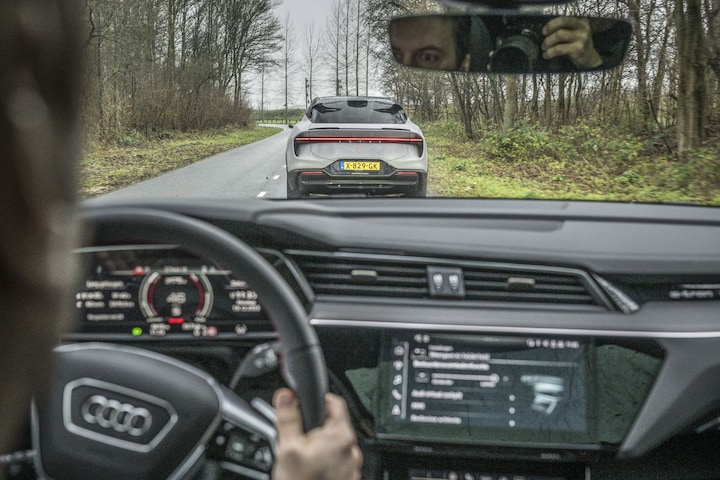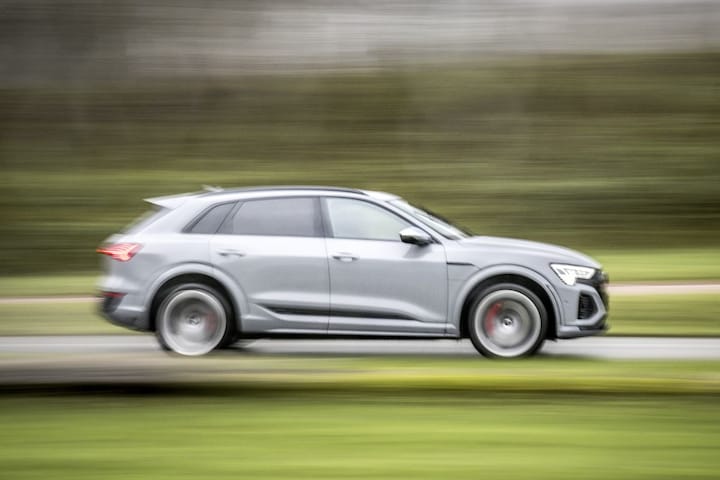A new start in a new world
With the Eletre, Lotus is starting a completely new era, in which large and massive are the norm. Properties that are far removed from the original core values of the English brand. That makes the shock even greater when the Eletre turns out to be an amazing car.
A Lotus against an Audi SQ8. Then I hope for some bearings or something…
Well, times change. Of course, almost every sports car manufacturer has an SUV on their shelves these days, but the buzz surrounding the Eletre is most reminiscent of the entrance of the first Porsche Cayenne. This step was so bizarre at the time that many did not hide their horror. It was “disgusting”, “disrespectful” and “the beginning of the end”. The practice was different, because Porsche now sells more SUVs than sports cars. And all this while it also puts one crazy sports car after another on the road. This means that no one has benefited from the Cayenne. Not enthusiasts and certainly not Porsche itself.
The arrival of the Eletre also caused similar skepticism. Now the die-hard fan base of Lotus is somewhat smaller than that of Porsche, especially in the Netherlands. But the step feels even bigger here. Even more than Porsche, the basis of Lotus is low weight with extremely pure driving sensations. That is a bizarre distance from an electric SUV that weighs more than 2,500 kilos. As if Range Rover suddenly unveiled a compact 900-kilo two-seater with a high-revving naturally aspirated four-cylinder. It really doesn’t fit the brand at all. But Lotus wants to continue, also with sports cars. And yes, even with petrol sports cars. The Emira has only been on the market for a year and the AMG four-cylinder version was only launched last summer. Simply made in Hethel, just across the North Sea. But the numbers are small and therefore too little is earned from it. The cash register has to ring and in the car world that works best with something that stands high on the legs. And if you’re making a new start, why not immediately focus on the latest technology? So electric. We look at where the Eletre stands against the electric version of the Audi SQ8.

In the sprint you can keep up with the Lotus up to 100 km/h
Yawn. So fast, but not that fun?
Surprisingly enough, the Lotus feels fast, but not as fast as you expect with this power. The sprint to 100 km/h is, at 4.5 seconds, just as ‘fast’ as the Audi with 100 hp less. A good Tesla Model 3 Longe Range is just as smooth! But this is because the Eletre S (unlike the R) does not have any form of launch control. The power is not immediately fully released, but builds up, with an emotional peak at 80 km/h. The faster you go, the faster the car feels. It’s like driving a high-revving V12. From 100 to 200 km/h takes just 7 seconds, compared to just 13 in the Audi! Once on the road, the Eletre quickly feels fed up. More impressive is its handling. Already at the first bend you notice that there is a magic in the Eletre that is almost always missed by newcomers. An extremely good steering feel combined with extremely tight driving behavior. But this again without the car being extremely hard. Lotus may now be Chinese, but the brand still has some knowledge of chassis. The car has air suspension in combination with the aforementioned active stabilization, which does wonders for the driving behavior of the 2.5-ton SUV. It was cold, wet and bleak, but the traction on the winter tires fitted was amazing. The chassis and power delivery adapt depending on the selected driving mode, where the bandwidth of the car is extremely wide. You immediately notice the difference in Sport because the bucket seats hug you more, ready for some explosive violence. The sensation of speed in the car is quite unique. Because more power is released at higher speeds, the acceleration also feels more extreme when you go faster and then the Lotus is suddenly bizarrely fast, but the sound is missing. This makes you go faster than you think. Strange idea that this is only the entry-level in terms of power. Considering the performance with winter rubber on wet, we are curious how the car feels on a dry spring day with summer tires… The speed potential is probably frightening.
It remains an SUV of course, and a large one at that. Lotus has therefore avoided any playfulness. Don’t expect a rear breakout to make powerslides or some lift-off oversteer: it’s mainly tight driving behavior. Even though there are brands that also make wilder SUVs in this segment, such as the BMW X5 M, Lotus’ choice with this size car is fine in our opinion.
And how does that Audi SQ8 drive?
When we switch into the Audi, it feels like a Turkish steam bath after a survival job. The Audi SQ8 is luxurious and spacious, and does not have the sporty vibe that the Lotus has. You have a sports seat, but not such an extreme seat as in the Lotus. That it is the S version is evident from the seats mentioned and some S logos here and there, but the changes compared to the e-Tron 55 are limited. The chassis does have some adjustments. The wheels are slightly further apart, you have wider tires and the camber is slightly sportier. The car does feel a bit firmer, but you lose some comfort. Driving is noticeably different than in the regular electric Q8. You have less body roll and the steering input ensures slightly faster responses from that car, which also weighs 2,600 kilos. It is also noticeably faster than the regular Q8 e-tron, which moves quite quietly for an EV. The SQ8 does have launch control, which, as mentioned, makes it just as fast as the Lotus up to 100 km/h. But where the Lotus scores mainly on the last stretch and is much faster above 100 km/h, the Audi SQ8 will win in a short drag race because it is noticeably faster off the line. Funny.

The Audi SQ8 is not extremely dynamic
But how does the Audi SQ8 steer when cornering?
This is where the two electric motors on the rear axle come to life. The motor on the outer wheel pushes the Audi hard around the corner, causing understeer to disappear like snow in the sun. It works better the faster you go, but it’s also the weird sensation because it needs force. When steering you are dependent on the front axle, only when you press the accelerator does the system come to life. A new way of driving, in which you have to explore what the Audi can do. And that’s more than you think. The problem is that the car communicates like many Audis. And that is not the best point of the brand’s sporty stuff. This is further emphasized next to the Lotus, which feels like a 911 GT3 next to an Audi S6. Yes, the S6 is a luxurious and fast car, but next to a GT3 it drives like a container. And that’s how it goes today. The Lotus is so good that the Audi, which drives quite well, feels very flat.
You can also read about this test in the latest edition of GTO, which will be in stores next week.
– Thanks for information from Autoweek.nl